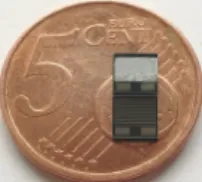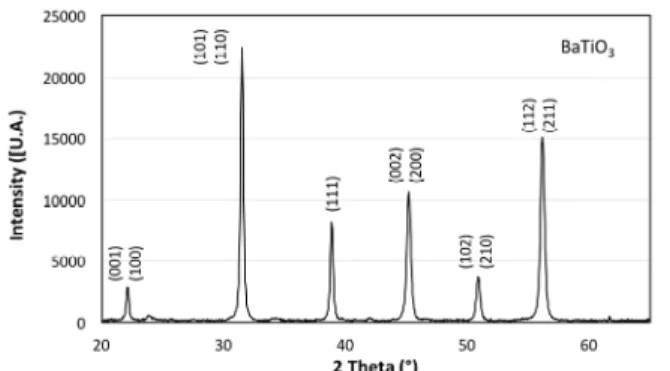HAL Id: hal-02529671
https://hal.archives-ouvertes.fr/hal-02529671
Submitted on 2 Apr 2020
HAL is a multi-disciplinary open access
archive for the deposit and dissemination of
sci-entific research documents, whether they are
pub-lished or not. The documents may come from
teaching and research institutions in France or
abroad, or from public or private research centers.
L’archive ouverte pluridisciplinaire HAL, est
destinée au dépôt et à la diffusion de documents
scientifiques de niveau recherche, publiés ou non,
émanant des établissements d’enseignement et de
recherche français ou étrangers, des laboratoires
publics ou privés.
Screen Printed BaTiO 3 for CO 2 Gas Sensor
Fabien Le Pennec, Sandrine Bernardini, Mohamad Hijazi, Carine
Perrin-Pellegrino, Khalifa Aguir, Marc Bendahan
To cite this version:
Fabien Le Pennec, Sandrine Bernardini, Mohamad Hijazi, Carine Perrin-Pellegrino, Khalifa Aguir, et
al.. Screen Printed BaTiO 3 for CO 2 Gas Sensor. The Fifth International Conference on Advances
in Sensors, Actuators, Metering and Sensing, Nov 2020, Valencia, Spain. �hal-02529671�
Screen Printed BaTiO
3for CO
2Gas Sensor
Fabien Le Pennec, Sandrine Bernardini, Mohamad Hijazi, Carine Perrin-Pellegrino, Khalifa Aguir and Marc
Bendahan
Aix Marseille Univ, Université de Toulon, CNRS, IM2NP, Marseille, France
e-mails: {fabien.lepennec, sandrine.bernardini, mohamad.hijazi, carine.perrin-pellegrino, khalifa.aguir, marc.bendahan} @im2np.fr
Abstract—In this work, we report on a new evaluation of metal oxide based on carbon dioxide sensors, using barium titanate nano-powder. The sensing principle is based on a change in conductance of semiconducting oxides when carbon dioxide is present. The sensitive layer was deposited on a SiO2/Si substrate by screen printing technology. The sensor responses were studied between 100 and 5000 ppm of carbon dioxide in the air with 50% relative humidity. The sensor presents good sensitivity toward carbon dioxide, with a stable baseline, and fast response and recovery time. These results are promising for carbon dioxide sensing.
Keywords-Gas Sensor; CO2; BaTiO3; Metal Oxide;
Environment.
I. INTRODUCTION
Carbon dioxide (CO2) is one of the main gases
responsible for the greenhouse effect and, consequently, the global warming trends. Hence, its monitoring is subject of a major societal challenge. With an outdoors concentration up to 500 ppm in urban areas, the ventilation balance is affected and the development of reliable low-cost CO2
sensors at multiple sites becomes an industrial strategy. Nowadays, the most commonly used method to detect CO2
is based on optical sensors. Despite their efficiency in CO2
detection, these technologies are expensive, have high electric consumption and are not fully miniaturized. Metal oxide gas sensors show potential features such as low-cost, mass production, miniaturization, fast response and recovery times.
In 1991, Ishihara et al. [1] first proposed a composite material based on p and n-type semiconductors, by mixing copper oxide (CuO) and barium titanate (BaTiO3) powders.
In 2001, Liao et al. [2] showed that pure CuO and pure BaTiO3 gave no response to CO2. Since then, these pure
materials have been definitively abandoned and only composites have been studied. But, the sensors of Liao et al. [2] were in the very basic form of large discs of sintered powders with unknown granularity, connected by Ag paste electrodes. Thus, we propose herein a new evaluation of BaTiO3based CO2sensors.
The rest of the paper is structured as follows. In Section II, we describe our approach based on BaTiO3nano-powder
deposition on platinum interdigitated electrodes by screen printing, a low cost, and an easily used technique. Then, in Section III, the sensing results are discussed based on a change in conductance of BaTiO3when CO2are introduced.
Finally, a conclusion is given in Section IV.
II. DESCRIPTION OF APPROACH AND TECHNIQUES
This description is composed of two parts; one is the sensing film fabrication; the other is the measurement system set-up.
A. Gas sensors
Our gas sensor is made of Ti/Pt interdigitated electrodes (5 and 100 nm, respectively) deposited on Si/SiO2 by
magnetron sputtering. BaTiO3thick films were deposited by
screen printing on these electrodes to produce a CO2
sensitive layer. BaTiO3 nano-powder (<100 nm, 4 g) was
mixed with glycerol (1.5 g) and screen printed on Si/SiO2
substrate with interdigitated platinum electrodes spaced by 50 μm (Figure 1).
Figure 1. Sample image of SiO2/Si substrate (4 x 4 mm2) with platinum
electrodes (bottom) and the final sensor with the BaTiO3thick film (top).
The deposited film was annealed at 400°C on a hotplate, in ambient air. The film structure was determined by X-Ray Diffraction (XRD) with a Philip’s X’Pert MPD equipment ( = 1.54 Å).
B. Setup
0.1 V DC voltage was applied to the sample while the electrical resistance was monitored by a homemade LabVIEW program using a Keithley Model 2450 Source Measure Unit (SMU) Instrument (Keithley, U.S.A.). Dry air (no humidity) was used as both the reference and the carrier gas. A gas dilution and humidification system generates an output mixture at the target CO2concentrations (1 to 5000
ppm) with a variable humidity (0% to 90%). The sensing properties of BaTiO3sensors were tested by measuring the
sensor resistance for 5 min under CO2diluted in dry air and
in humid air with a standard Relative Humidity (RH) value of 50 %. The sensors were operated at several temperatures from 200°C to 300°C on a hotplate. A constant total flow was maintained at 500 Standard Cubic Centimeters per Minute (SCCM) via mass flow controllers.
6 Copyright (c) IARIA, 2020. ISBN: 978-1-61208-766-5
III. RESULTS ANDDISCUSSIONS
The XRD diffractogram of BaTiO3thick film (Figure 2)
shows the presence of BaTiO3nanocrystals in the tetragonal
phase of BaTiO3[3].
Figure 2. BaTiO3diffractogram using=1.54Å (Philip’s X’Pert MRD).
The BaTiO3 sensors for different CO2 concentrations
provide a measurable response depending on the CO2
concentrations in the 100 - 5 000 ppm range and 50% RH at various temperatures. The higher response amplitude variations were obtained at 280°C. Figures 3 and 4 show, respectively, the response and the sensitivity of the BaTiO3
sensor under CO2 in the air with 50% RH at 280 °C, the
optimum working temperature. It gives reversible responses to CO2concentrations between 100 ppm and 5000 ppm.
Figure 3. Resistive responses of BaTiO3to six CO2concentrations
with 50% RH at 280°C.
The sensor response is defined in (1) as the ratio between the sensor resistance under CO2 exposure and the sensor
resistance in the air:
R = Rgas/ Rair (1)
where Rairis the sensor resistance through humid airflow and
Rgasthe sensor resistance in the presence of CO2.
The response time was less than 2 minutes and the recovery time was about 5 minutes. The responses are proportional to the CO2 concentrations, and they restored
the original baseline in less than 5 minutes.
Figure 4. Sensitivity response of BaTiO3to different concentrations of CO2
with 50% RH at 280°C.
These results are in agreement with the recent review on chemiresistive CO2gas sensors [4].
IV. CONCLUSIONS
This work reported preliminary results on a screen printing BaTiO3sensor working at an optimum temperature
of 280°C and for 50% RH. Our experiments showed stable baseline responses with fast response/recovery times towards CO2. These sensors seem promising for measuring
indoor and outdoor air quality and for CO2 detection.
However, after a few weeks, using the same operational conditions, the sensor responses were weakened on the record. New experiments and analyses are in progress to understand this phenomenon.
ACKNOWLEDGMENT
The authors thank Mr. A. Combes and Dr. T. Fiorido for their technical support.
REFERENCES
[1] T. Ishihara, K. Kometani, M. Hashida, and Y. Takita, "Application of Mixed Oxide Capacitor to the Selective Carbon Dioxide Sensor", J. Electrochem. Soc., 138, 1991, pp. 173-176, doi: 10.1149/1.2085530.
[2] B. Liao, Q. Wei, K. Wang, and Y. Liu, "Study on CuO–BaTiO3
semiconductor CO2", Sens. Actuators B:Chem., 80, 2001, pp.
208-214, doi: 10.1016/S0925-4005(01)00892-9.
[3] H. E. Swanson, R. K. Fuyat, and G. M. Ugrinic, "X-ray diffraction powder patterns" National Bureau of Standards, Circular 539, 3, 1954, pp. 44.
[4] Y. Lin and Z. Fan, "Compositing strategies to enhance the performance of chemiresistive CO2 gas sensors", Materials
Science in Semiconductor Processing, vol. 107, 2020, pp. 104820-104841, doi: 10.1016/j.mssp.2019.104820.
7 Copyright (c) IARIA, 2020. ISBN: 978-1-61208-766-5

